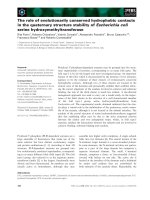Báo cáo khoa học: "The role of adjuvant pelvic radiotherapy in rectal cancer with synchronous liver metastasis: a retrospective study" doc
Bạn đang xem bản rút gọn của tài liệu. Xem và tải ngay bản đầy đủ của tài liệu tại đây (1.57 MB, 7 trang )
RESEARC H Open Access
The role of adjuvant pelvic radiotherapy in
rectal cancer with synchronous liver metastasis:
a retrospective study
Jun Won Kim
1
, Yong Bae Kim
1
, Nam-Kyu Kim
2
, Byung-Soh Min
2
, Sang Joon Shin
3
, Joong Bae Ahn
3
,
Woong Sub Koom
1
, Jinsil Seong
1
, Ki Chang Keum
1*
Abstract
Background: Synchronous liver metastases are detected in approximately 25% of colorectal cancer patients at
diagnosis. The rates of local failure and distant metastasis are substantial in these patients, even after undergoing
aggressive treatments including resection of primary and metastatic liver tumors. The purpose of this study was to
determine whether adjuvant pelvic radiotherapy is beneficial for pelvic control and overall survival in rectal cancer
patients with synchronous liver metastasis after primary tumor resection.
Methods: Among rectal cancer patients who received total mesorectal excision (TME) between 1997 and 2006 at
Yonsei University Health System, eighty-nine patients diagnosed with synchronous liver metastasis were reviewed.
Twenty-seven patients received adjuvant pelvic RT (group S + R), and sixty-two patients were managed without RT
(group S). Thirty-six patients (58%) in group S and twenty patients (74%) in group S+R received local treatment for
liver metastasis. Failure patterns and survival outcomes were analyzed.
Results: Pelvic failure was observed in twenty-five patients; twenty-one patients in group S (34%), and four
patients in group S+R (15%) (p = 0.066). The two-year pelvic failure-free survival rates (PFFS) of group S and group
S+R were 64.8% and 80.8% (p = 0.028), respectively, and the two-year overall survival rates (OS) were 49.1% and
70.4% (p = 0.116), respectively. In a subgroup analysis of fifty-six patients who received local treatment for liver
metastasis, the two-year PFFS were 64.9% and 82.9% (p = 0.05), respectively; the two-year OS were 74.1% and
80.0% (p = 0.616) in group S (n = 36) and group S+R (n = 20), respectively.
Conclusions: Adjuvant pelvic RT significantly reduced the pelvic failure rate but its influence on overall survival
was unclear. Rectal cancer patients with synchronous liver metastasis may benefit from adjuvant pelvic RT through
an increased pelvic control rate and improved quality of life.
Background
According to the data on cancer incidence between
2003 and 2005 from the Korea Central Cancer Registry,
colorectal cancer (CRC) is the fourth most common
cancer in men (37.9%) after cancers of the stomach
(66.0%), lung (48.5%), and liver (44.9%). According to
the same data set, colorectal cancer is the fourth most
common cancer in Korean women (28.0%) after breast
(37.3%), thyroid (36.2%), and stomach (34.1%) cancers.
When the annual incidence of CRCs in 2005 was com-
pared to that in 1999, there was an increase of 150% in
men and 135% in women; CRC was shown to be one of
the most sharply increased malignancies in Korea [1].
The annual disease-specific death rate for colorectal
cancer is approximately 40% and liver metastases are
found in approximately two-thirds of these patients [2],
while synchronous liver metastases are found in 20% to
30% of colorectal cancer patients at initial diagnosis [3].
In rectal cancer patients with liver metastasis, conser-
vative management including diverting colostomy
resulted in a median survival of approximately three to
five months, while resection of the primary tumor
* Correspondence:
1
Department of Radiation Oncology, Yonsei Cancer Center, Yonsei University
College of Medicine, Yonsei University Health System, 134 Sinchon-dong,
Seodaemun-gu, Seoul, 120-752, Korea
Full list of author information is available at the end of the article
Kim et al. Radiation Oncology 2010, 5:75
/>© 2010 Kim et al; licensee BioMed Central Ltd. This is an Open Access article distributed under the terms of the Creative Commons
Attribu tion License ( which permits unrestricted use, distribution, and reproductio n in
any medium, provided the original work is properly cited.
increased median survival to fourteen to twenty-four
months [4-6]. Resection of both the primary and meta-
static liver tumors resulted in a median survival of
thirty-seven months and a five-year survival rate of 25-
35% [7,8]. Despite an increased chance of survival fol-
lowing resection of the primary and metastatic liver
tumors, the reported rate of pelvic failure was approxi-
mately 30-35% and the rate of extra-hepa tic metastases
was up t o 67% [9,10]. The cause of d eath for many
patients was either pelvic failure or distant extra-hepati c
metastases. The rate of treatment failure is curr ently on
the rise because patients live longer due to improved
efficacy of treatment modalities; pelvic failures or
uncontrolled primary tumors may threaten patient sur-
vival and quality of life in these cases.
According to 2010 National Comprehensive Cancer
Network (NCCN) guideline, preoperative CCRT has
become the standard care in locally advanced rectal can-
cer. However, when patients are diagnosed with syn-
chronous liver metastasis, preoperative CCRT is no
longer a part of standard care, and many physicians
decide against postoperative CCRT even at high risk of
local recurrence. Despite the consensus that adjuvant
pelvic RT provides survival benefit for stage II and III
rectal cancer [11], the role of adjuvant pelvic RT in rec-
tal cancer with synchronous liver metastasis has not
been defined. In this study, we investigated the clinical
implications of adjuvant pelvic RT following primary
tumor resection in rectal cancer patients with synchro-
nous liver metastasis.
Methods
Patient eligibility
Bet ween 1997 and 2006, 306 pati ents with rectal cancer
and synchronous liver metast asis were treated at Yonsei
Cancer Center, Severance Hospital (Seoul, Republic of
Korea). Synchronous liver metastasis was diagnosed dur-
ing work-up, at the time of operation, or within three
months after definitive treatment. A total of eighty-nine
patients who underwent surgical resection of the pri-
mary tumor and/or local treatment for liver m etastasis
were retrospectively analyzed. Patients who did not
receive resection of the primary tumor were excluded
from this study. Patients who had synchronous extra-
hepatic metastases, pathology other than adeno carci-
noma, inadequate medical reco rds, or patients who
rece ived preoperative chemoradiatio n or refused recom-
mended treatments were also excluded from the study.
Each patient was evaluated through history, physical
examination, routine blood tests, chest radiography, and
other relevant studies. Pretreatment studies included
computerized tomography (CT) or magnetic resonance
imaging ( MRI) of the primary tumo r site. Patients were
routinely evaluated with abdominal-pelvic CT for liver
metastasis.
Since all patients had liver metastasis without presence
of extrahepatic metastasis at diagnosis, we used Duke
staging to describe the status of primary tumor and pel-
vic lymph node metastasis. The liver metastasis status
was classified according to Pettavel and Morgenthaler
staging [12]. Stage I was defined as a solitary or small
metastasis, stage II was defined as two or three metas-
tases with a maximum diameter less than or equal to 2
cm, and stage III was defined as numerous and large
metastases or the presence of hepa tomegaly and/or
ascites (Table 1 and Figure 1). Among 89 patients
reviewed, 27 patients received adjuvant pelvic RT (group
S + R), and 62 patients were managed without adjuvant
RT (group S). The median follow-up periods were
twenty-five months (range 6 to 138 months) for all 89
patients and 62 months (range 22 to 138 months) for
surviving patients (n = 28). There was no significant dif-
ference in the median follow up periods of 34 months
(range 6-138 months) for group S+R and 24 months
(rage 6-96 months) for group S.
Treatment profiles
All patients included in this study received total mesorec-
tal excision (TME) by means of either low anterior resec-
tion (n = 72), abdominoperineal resection (n = 13), or
Hartmann’s operation (n = 4). Treatments for metastatic
liver tumors included lobectomy, wedge resection, radio-
frequency ablation (RFA), and transarterial chemoemboli-
zation (TACE) with intra-arterial chemotherapy for
localized liver metastases; systemic chemotherapy was
administered for extensive liver metastases. Hepatic resec-
tion was performed in a patient whose metastatic hepatic
tumor was determined to be resectable based on location
of tumor, extent of disease, and adequate hepatic function.
For metastatic tumors smaller than 3 cm in diameter, RFA
was recommended as an alternative treatment for patients
who were not candidates for surgery due to the poor ana-
tomical location of the liver metastases, insufficiency in
the functional h epatic reserve following a resection, or a
co-morbidity that prohibited major surgery. All modalities
except TACE plus intra-arterial chemotherapy were con-
sidered local treatments for liver metastasis.
Twenty-four out of 27 patients who received post-
operative pelvic RT underwent adjuvant 5-FU/
Table 1 Pettavel and Morgenthaler’s Staging for
Colorectal Hepatic Metastases
Stage I solitary or small
Stage II few (maximum diameter = 2 cm)
Stage III numerous and large (hepatomegaly, ascites)
Kim et al. Radiation Oncology 2010, 5:75
/>Page 2 of 7
leucovorin (FL) chemotherapy. The regimen consisted of
a 5-FU (450 mg/m
2
/day) intravenous bolus infusion with
leucovorin (20 mg/m
2
/day) for five consecutive days
every four weeks for twelve cycles. The first two cycles
of FL chemotherapy were given alone following surgery,
with the remaind er administered concurrently wit h
radiation. To three patients, who were treated between
1997 and 2000 but did not receive postoperative pelvic
RT, adjuvant FL chemotherapy was given up to 12
cycles. Fifty-nine patients who were treated after the
year 2000 and did not receive postoperative pelvic RT
were subject to adjuvant chemotherapy with 5-FU/leu-
covorin/oxaliplatin (FOLFOX) or 5-FU/leucovorin/irri-
notecan (FOLFIRI). The FOLFOX regimen consisted of
oxaliplatin 85 mg/m
2
on day one, followed by a bolus of
5-FU at 400 mg/m
2
andLVat200mg/m
2
on days one
and two with infusio nal 5-FU at 600 mg/m
2
for twenty-
two hours on days one and two. The FOLFIRI regimen
consisted of irino tecan at 180 mg/m
2
on day one with
leucovorin at 400 mg/m
2
administered as a two hour
infusion before 5-FU at 400 mg/m
2
being administered
as an intravenous bolus injection, followed by 5-FU at
600 mg/m
2
as a twenty-two hour infusion immediately
after the 5-FU bolus injection on days one and two.
The postoperative radiation treatment consisted of
mega-voltage photon beams delivered either in a three-
field plan (posteroanterior and two lateral fields) or a
four-field box plan. The top of the treatment field was
placed at the L4-5 junction, with the lateral borders 1-2
cm outside the bony pelvis, and the inferior margin at 4
cm below the tumor. A total dose of 41.4 to 45 Gy was
delivered to the whole pelvis including the tumor bed
and pelvic lymph nodes and a boost dose of 9 to 12.6
Gy was delivered to the tumor bed in a 1.8 Gy daily
fraction. Boost volume consisted of areas of initial
tumor, surrounding mesorectum, anastomosis site and
presacral area.
Because patients were diagnosed with synchronous
liver metastasis, the NCI guideline for postoperative pel-
vic RT was not strictly followed and decisions for adju-
vant pelvic RT were made at physicians’ discretion. In
Table 2, although not statistically significant, group S+R
shows higher rates of lymph node metastasis (Duke C),
Figure 1 Pettavel and Morgenthaler’s Staging for colorectal hepatic metastases. (A) CT imaging for stage I, (B) CT imaging for stage II, and
(C) MRI imaging for stage III disease.
Table 2 Patient Characteristics (n = 89)
S S + RT P value
No. of Patients 62 27
Sex (M:F) 45:17 19:8
Age (years)(mean) 25-80 (57) 23-66 (53)
Duke stage 0.211
A or B 13 (21%) 3 (11%)
C 49 (79%) 24 (89%)
Liver mets stage 0.561
I or II 28 (45%) 14 (52%)
III 34 (55%) 13 (48%)
Pelvic surgery
APR 9 (15%) 4 (15%)
LAR 51 (82%) 21 (78%)
Hartmann 2 (3%) 2 (7%)
Lateral resection margin NS
Positive 10 (16%) 3 (11%)
Negative 52 (84%) 24 (89%)
Liver surgery 0.151
Resection 22 (61%) 16 (80%)
RFA 4 (11%) 2 (10%)
Resection + RFA 10 (28%) 2 (10%)
Chemotherapy
FL 3 24
FOLFOX 37 2
FOLFIRI 22 1
Liver metastasis staging according to Pettavel and Morgenthaler
Abbreviations: APR = abdominoperineal resection; LAR = low anterior
resection; RFA = radiofrequency ablation; FL = 5-FU/leucovorin; FOLFOX =
5-FU/leucocovor in/oxaliplatin; FOLFIRI = 5-FU/leucovorin/irrinotecan.
Kim et al. Radiation Oncology 2010, 5:75
/>Page 3 of 7
localized liver metastasis (liver stage I o r II), and liver
resection. These results indicate that patients with con-
trolled liver metastasis who had a higher risk of pelvic
recurrenceweresubjectedtopostoperativepelvicRT.
At our institution, patients who underwent adjuvant
chemotherapy with FOLFOX or FOLFIRI regimen were
not recommended for concurrent radiotherapy due to
increased toxicity and this result is shown in Table 2.
Statistical analysis
Theprimaryendpointofthestudywaspelvicfailure
free survival (PFFS). PFFS was defined as any relapse
within the pelvic cavity. The PFFS rate and overall
actuarial survival rate were cal culated. Actuarial curves
were plotted using the Kaplan-Meier method; tests of
significance among actuarial data were based on the log-
rank statistic. Multivariate proportional hazards regres-
sion analysis was done using standard techniques with
the log-linear hazard function of the Cox model. The
prognostic factors that revealed p values < 0.30 in uni-
variate analysis were included for multivariate analysis.
Differences between means, proportions, and distribu-
tions were evaluated by Chi-square testing. For actuarial
data, p values ≤ 0.05 were considered statistically
significant.
Results
Patient characteristics
The median age was 56 years (range 23-80 years), and
72% of the s tudy population was male. Duke stage C
was reported in 73 patients (82%), and 47 patients (53%)
were diagnosed with liver metastasis stage III. LAR was
the most frequently performed type of surgery for resec-
tion of the primary tumor (81%). For the 56 patients
who received local treatment for liver metastasis, resec-
tion including and lobectomy and wedge resection was
the most frequently used method (68%).
We divided the patient population into two groups;
group S+R consisted of twenty-seven patients who
received resection of the pri mary tumor and a djuvant
pelvic RT and group S, which consisted of sixty-two
patients who were managed with primary tumor resec-
tion without pelvic irradiation. Patient characteristics
and clinical profiles are listed in Table 2. No significant
differences were observed in the distribution of primary
and metastatic liver stages or in the local treat ment for
liver metastasis between the two groups. Liver metasta-
sisstageIIIwasmorefrequentlyfoundingroupSthan
in group S+R (55% vs. 48%) with no statistical signifi-
cance. The number of patients who received local treat-
ment for liver metastasis was thirty-six (58%) in group S
and t wenty (74%) in group S+R. Positive lateral margin
from primary tumor resection was found in 10 patients
(16%) from group S and 3 patients (11%) from group
S+R with no significant difference between the two
groups.
Treatment outcome
The median two-year overall survival for all 89 patients
was 55.7%. The two-year overall survival was 49.1% for
group S and 70.4% for group S+R, and no significant
difference in overall survival was observed between the
two groups (p = 0.116) (Figure 2B). No radiation
induced gastrointestinal toxicity greater than Radiation
Therapy Oncology Group (RTOG) grade 2 was noted in
group S+R. During follow-up, pelvic failure was
observed in twenty-five patients; twenty-one patients
(34%) in group S and four patients (15%) in group S+R
(p = 0.066). Forty-one patients developed distant metas-
tases, and there wa s no significant differen ce between
groupSandgroupS+Rinthisregard(42%vs.56%,
p = 0.236, respectively). Patterns of failure are summar-
ized in Table 3. The two-year pelvic failure-free survival
rates of group S and group S+R were 64.8% and 80.8%,
respectively. Group S+R demonstrated a significantly
higher pelvic failure-free survival rate (p = 0.028) (Figure
2A). Among the four patients with pelvic failure in
group S+R, one patient received salvage surgery and RT,
two patients receive chemotherapy and one patient
received palliative RT and chemotherapy. Among the
twenty-one patients who experienced pelvic failure in
group S, one patient received salvage surgery, four
patients received palliative RT and chemotherapy, eight
patients received chemotherapy and seven patients were
managed with conservative care only.
A univariate analysis was carried out on clinical fac-
tors including patients’ age, Duke stage, initial CEA
level, lateral resection margin, liver metastasis stage,
local treatment for liver metastasis, an d adjuvant pelvic
RT, in order to determine their influence on pelvic con-
trol and overall survival. For pelvic failure-free survival,
positive lateral resection margin of the primary tumor
and adjuvant pelvic RT were significantly related with
improved pelvic failure-free survival, and their indepen-
dent association with survival was verified by a multi-
variate analysis (Table 4). Local treatment for liver
metastasis demonstrated a significant correlation with
improved overall survival. Although not s tatistically sig-
nificant, positive lateral resection margin of the p rimary
tumor and initial CEA > 100 ng/ml d emonstrated
adverse correlation with regards to overall survival. In a
multivariate analysis , local treatment for liver metastasis
proved to be an independent prognostic factor for over-
all survival (Table 5).
In order to minimize the influence of metastatic liver
disease on the rates of pelvic failure and overall survival,
a subgroup analysis was carried out on the fifty-six
patients who received primary tumor resection and local
Kim et al. Radiation Oncology 2010, 5:75
/>Page 4 of 7
treatment for liver metastasis before receiving pelvic RT.
The two year pelvic failure-free survival rates were
64.9% and 82.9% (p = 0.05) and two-year overall survival
rates were 74.1% and 80.0% (p =0.616)forgroupS
(n = 36) and group S+R (n = 20), respectively.
Discussion
Metastatic spread of colorectal cancer occurs mainly via
the portal system and the incidence of isolated liver
metastasis in rectal cancer is seven t imes higher than
isolated liver metastasis in other cancers [2]. The larger
volume o f blood supply to the liver in comparison with
other organs and the tendency of cancer cells to deposit
and multiply in the liver after passing through the portal
system may explain the organ-specific metastasis of col-
orectal cancer [7]. Patients with liver metastasis, how-
ever, should not be deprived of available treatment
options. Finlay et al., e stimated the mean d oubling time
of liver metastases from rectal cancer to be 155 days
[13]. The relatively slow gr owth of liver metastasis sug-
gests a potent ial survival benefit with aggressive treat-
ments in rectal cancer patients who have liver
metastasis.
Although rectal cancer patients with synchronous liver
metastasis have been treated conservatively with pallia-
tive colostomy or bypass surgery in the past, an increas-
ing number of these patients undergo resection of the
primary rectal cancer as well as local treatment for liver
metastasis. The survival rate of these patients has been
gradually improving as an increasing number of patients
are undergoing surgical treatments. Improvement in
surgical techniques, e specially for liver resection, is also
a contributing factor for increased survival. However,
only 20% of liver metastases are found to be resectable
at diagnosis; only 25 to 40% of patients undergoing
resection experience long term survival [14-16] since
many of these patients die of metastasis to the lungs,
bone, and other extra-hepatic sites.
Resection of rectal tumors and treatment of liver
metastases can benefit patients by reducing tumor bur-
den and slowing the progression of liver metastasis;
thus, these patients are more likely to have a longer
Figure 2 Survival of rectal cancer patients with synchronous liver metastasis after postoperative pelvic RT. (A) Pelvic failure-free survival
and (B) Overall survival rates.
Table 3 Patterns of Treatment Failure
No. of Patients
Failure pattern S (n = 62) S + RT (n = 27) P value
Pelvic failure 21 (34%) 4 (15%) 0.066
Distant failure 26 (42%) 15 (56%) 0.236
Table 4 Univariate and Multivariate Analyses for Pelvic
Failure-Free Survival
Prognostic
Factor
Group PFFS
(%)
Univariate Multivariate RR 95%
CI
Age (years) < 57 73 0.531 −
≥ 57 77
Duke stage A or B 88 0.399 −
C64
Rectal lateral
margin
negative 73 0.045 0.05 2.6 1.0-
6.6
positive 51
Initial CEA
(ng/ml)
< 100 67 0.694 −
≥ 100 73
Adjuvant
pelvic RT
no 65 0.028 0.04 0.3 0.1-
0.9
yes 81
Abbreviations: CEA = carcinoembryonic antigen; PFFS = pelvic failure free
survival; RR = relative risk; CI = confidence interval
Kim et al. Radiation Oncology 2010, 5:75
/>Page 5 of 7
disease-free survival and a longer stabilized disease state.
However, surgical resection of the primary tumor and
treatment of liver metastasis do not eliminate the risk of
pelvic failure. Rectal cancer patients with liver metastasis
are more likely to have higher T and N stages (i.e., a
higher rate of transmural penetration and nodal involve-
ment) [4]. These patients are at a high risk of pelvic
recurrence following initial treatment, and thus suffer
from shortening of disease-specific survival.
Although postoperative pelvic irradiation is known to
increase survival by reducing pelvic failure rates and dis-
tant metastasis in locally advanced rectal cancer patients
[17], its role is unclear in patients with synchronous
liver metastasis. To date, few reports have been pub-
lished on the benefit of pelvic RT when patients have
synchronous distant metastasis. Crane et al.,have
reported that pel vic irradiation has a palliative role in
treating rectal cancer liver metastasis [18]. Eighty
patients with synchronous distant metastases from rectal
cancer were treated with chemoradiation or chemora-
diation followed by primary tumor resection. Symptoms
from the primary tumor resolved in 90% of all patients
and symptomatic pelvic control rates were 81% and 91%
in the chemoradiation and chemoradiation + surgery
groups, respectively. Durable pelvic control was safely
achieved without c olostomy in most rectal cancer
patients with synchronous systemic metastases by
means of pelvic chemoradiation.
In our study, postoperative pelvic RT reduced the pel-
vic failure rate in rectal cancer patients with synchro-
nous liver metastasis compared with the patients who
underwent surgery alone. Positive lateral resection
margin of the primary tumor and adjuvant pelvic RT
influenced pelvic failure-free survival as independent
prognostic factors. Among the twenty-seven patients
who received postoperative pelvic RT, pelvic f ailure
occurred in only two in fourteen patients with early
stage liver metastasis (stage I/II) and in two in thirteen
patients with late stage liver metastasis (stage III). These
results suggest that pelvic RT may benefi t all patients
regardless of the status of their liver metastasis. H ow-
ever, the number of patients who received r esection of
the primary tumor despite stage III liver metastasis is
small and the role of postoperative pelvic RT in exten-
sive liver metastasis needs to be verif ied by future stu-
dies. In a subgroup analysis consisting of 56 patients
who received local treatment for liver metastasis, post-
operative pelvic RT also showed improvement in pelvic
control rate. Overall survival, however, demonstrated no
significant difference between group S and group S+R.
Local treatment for liver metastasis was the only in de-
pendent prognostic factor for overall survival. A pro-
spective study with a larger group of patients and a
more thorough follow up may reveal translation of
improved local control into survival benefit.
Conclusion
In the current practice, the majority of physicians do
not consider pelvic irradiation as a part of standard
treatment when patients are diagnosed with rectal can-
cer and synchronous liver metastasis. Our study showed
that postoperative pelvic RT in rectal cancer patients
with synchronous liver metastasis increased PFFS
whether or not the patient received a local treatment for
liver metastasis. We suggest that these patients may
benefit from postoperative adjuvant pelvic RT through
an increased pelvic control rate and improved quality of
life.
Author details
1
Department of Radiation Oncology, Yonsei Cancer Center, Yonsei University
College of Medicine, Yonsei University Health System, 134 Sinchon-dong,
Seodaemun-gu, Seoul, 120-752, Korea.
2
Department of Surgery, Yonsei
Cancer Center, Yonsei University College of Medicine, Yonsei University
Health System, 134 Sinchon-dong, Seodaemun-gu, Seoul, 120-752, Korea.
3
Department of Internal Medicine, Yonsei Cancer Center, Yonsei University
College of Medicine, Yonsei University Health System, 134 Sinchon-dong,
Seodaemun-gu, Seoul, 120-752, Korea.
Authors’ contributions
JK contributed in data collection, performed statistical analysis and drafted
the manuscript. YK contributed in design and coordination of the study and
critical revision of the manuscript. KK conceived of the study, contributed in
patient accrual, participated in study design, and gave final approval of the
manuscript to be published. NK, BM, SS, JA, WK, and JS contributed in
patient accrual. All authors read and approved the final manuscript.
Competing interests
The authors declare that they have no competing interests.
Table 5 Univariate and Multivariate Analyses for Overall
Survival
Prognostic
Factor
Group OS
(%)
Univariate Multivariate RR 95%
CI
Age (years) < 57 63 0.247 −
≥ 57 48
Duke stage A or B 68 0.297 −
C53
Rectal lateral
margin
negative 59 0.078 0.029 2.2 1.1-
4.5
positive 37
Initial CEA (ng/
ml)
< 100 59 0.081 0.47 1.3 0.6-
2.7
≥ 100 33
Liver resection no 27 0.000 0.0 2.3 0.2-
0.6
yes 76
Adjuvant pelvic
RT
no 49 0.224 -
yes 70
Abbreviations: CEA = carcinoembryonic antigen; OS = overall survival; RR =
relative risk; CI = confidence interval
Kim et al. Radiation Oncology 2010, 5:75
/>Page 6 of 7
Received: 7 June 2010 Accepted: 31 August 2010
Published: 31 August 2010
References
1. Shin H: Nationwide Cancer Incidence in Korea, 2003-2005. Jounal of
Preventive Medicine and Public Health 2008, 41:84-91.
2. Cady B, Stone MD: The role of surgical resection of liver metastases in
colorectal carcinoma. Seminars in oncology 1991, 18:399-406.
3. August DA, Ottow RT, Sugarbaker PH: Clinical perspective of human
colorectal cancer metastasis. Cancer and metastasis reviews 1984,
3:303-324.
4. Wanebo HJ, Semoglou C, Attiyeh F, Stearns MJ: Surgical management of
patients with primary operable colorectal cancer and synchronous liver
metastases. The American journal of surgery 1978, 135:81-85.
5. Cady B, Monson DO, Swinton NW: Survival of patients after colonic
resection for carcinoma with simultaneous liver metastases. Surgery,
gynecology & obstetrics 1970, 131:697-700.
6. Adson MA, van Heerden JA, Adson MH, Wagner JS, Ilstrup DM: Resection
of hepatic metastases from colorectal cancer. Archives of surgery 1984,
119:647-651.
7. Steele G, Bleday R, Mayer RJ, Lindblad A, Petrelli N, Weaver D: A
prospective evaluation of hepatic resection for colorectal carcinoma
metastases to the liver: Gastrointestinal Tumor Study Group Protocol
6584. Journal of clinical oncology 1991, 9:1105-1112.
8. Hughes KS, Rosenstein RB, Songhorabodi S, Adson MA, Ilstrup DM,
Fortner JG, Maclean BJ, Foster JH, Daly JM, Fitzherbert D: Resection of the
liver for colorectal carcinoma metastases. A multi-institutional study of
long-term survivors. Diseases of the colon & rectum 1988, 31:1-4.
9. Bozzetti F, Doci R, Bignami P, Morabito A, Gennari L: Patterns of failure
following surgical resection of colorectal cancer liver metastases.
Rationale for a multimodal approach. Annals of surgery 1987, 205:264-270.
10. Ekberg H, Tranberg KG, Andersson R, Lundstedt C, Hägerstrand I, Ranstam J,
Bengmark S: Pattern of recurrence in liver resection for colorectal
secondaries. World journal of surgery 1987, 11:541-547.
11. Mohiuddin M, Marks G: Adjuvant radiation therapy for colon and rectal
cancer. Seminars in oncology 1991, 18:411-420.
12. Pettavel J: Protracted arterial chemotherapy of liver tumors: an
experience of 107 cases over a 12-year period. Progress in Clinical Cancer
1978, 217-233.
13. Finlay IG, Meek D, Brunton F, McArdle CS: Growth rate of hepatic
metastases in colorectal carcinoma. The British journal of surgery 1988,
75:641-644.
14. Scheele J: Surgical resection of colorectal liver metastases: Gold standard
for solitary and radically resectable lesions. Swiss Surgery 1996, 4:4-17.
15. Ambiru S, Miyazaki M, Isono T, Ito H, Nakagawa K, Shimizu H, Kusashio K,
Furuya S, Nakajima N: Hepatic resection for colorectal metastases:
analysis of prognostic factors. Diseases of the colon & rectum 1999,
42:632-639.
16. Stangl R, Altendorf-Hofmann A, Charnley RM, Scheele J: Factors influencing
the natural history of colorectal liver metastases. Lancet 1994,
343:1405-1410.
17. Thomas PR, Lindblad AS: Adjuvant postoperative radiotherapy and
chemotherapy in rectal carcinoma: a review of the Gastrointestinal
Tumor Study Group experience. Radiotherapy and Oncology 1988,
13:245-252.
18. Crane CH, Janjan NA, Abbruzzese JL, Curley S, Vauthey J, Sawaf HB,
Dubrow R, Allen P, Ellis LM, Hoff P, et al: Effective pelvic symptom control
using initial chemoradiation without colostomy in metastatic rectal
cancer. International journal of radiation oncology, biology, physics 2001,
49:107-116.
doi:10.1186/1748-717X-5-75
Cite this article as: Kim et al.: The role of adjuvant pelvic radiotherapy
in rectal cancer with synchronous liver metastasis: a retrospective
study. Radiation Oncology 2010 5:75.
Submit your next manuscript to BioMed Central
and take full advantage of:
• Convenient online submission
• Thorough peer review
• No space constraints or color figure charges
• Immediate publication on acceptance
• Inclusion in PubMed, CAS, Scopus and Google Scholar
• Research which is freely available for redistribution
Submit your manuscript at
www.biomedcentral.com/submit
Kim et al. Radiation Oncology 2010, 5:75
/>Page 7 of 7









